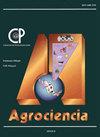POTENTIAL USE OF PHYSICAL CHARACTERISTICS OF SQUASH SEEDS (Cucurbita moschata), PEA PODS (Pisum sativum) AND GREEN BEAN (Phaseolus vulgaris) IN AGROINDUSTRY 4.0
IF 0.5
4区 农林科学
Q4 AGRICULTURE, MULTIDISCIPLINARY
引用次数: 0
Abstract
Castilla squash (Cucurbita moschata), pea pods (Pisum sativum) and pinto Saltillo green bean (Phaseolus vulgaris) seed shells are considered organic wastes due to the lack of knowledge about their physical, nutritional and medicinal characteristics and their relevance in agroindustrial production. The consumption of functional, synthetic and semi-synthetic products increases worldwide, as does the need for research on non-traditional species with agroindustrial potential. The objective of this research was to analyse the physical characteristics of Castilla squash seeds with shells, whole pods of Saltillo pinto green bean, and pea pods, and to transform them into flours to identify their potential use in Agroindustry 4.0. Pea pods showed the greatest width (11.17 mm) and thickness (9.19 mm), the greatest length was found in green bean pods (125.18 mm), while squash seeds showed the lowest values in these three variables. The squash seed flour presented higher internal friction (0.98) and higher external friction on wood (1.32) as did the pea pod flour (1.33) also on wood. In contrast, the mean values of strain percentage by hardness, recovery after work and specimen length showed no statistical difference (p > 0.05) between the masses. These flours meet the specifications of the Mexican standard for wheat flour; therefore, they can be used in blends to fortify products or in the manufacture of industrial machines for processing the raw material.南瓜种子(Cucurbita moschata)、豌豆荚(Pisum sativum)和绿豆(Phaseolus vulgaris)物理特性在农业工业4.0中的潜在应用
卡斯蒂亚南瓜(Cucurbita moschata),豌豆荚(Pisum sativum)和pinto Saltillo绿豆(Phaseolus vulgaris)种子壳由于缺乏对其物理,营养和药用特性及其在农业工业生产中的相关性的了解而被认为是有机废物。全世界对功能性、合成和半合成产品的消费增加了,对具有农业工业潜力的非传统物种的研究也需要增加。本研究的目的是分析Castilla南瓜种子的物理特性,包括外壳、Saltillo pinto绿豆的整个豆荚和豌豆荚,并将其转化为面粉,以确定其在农业工业4.0中的潜在用途。豌豆荚的宽度和厚度最大,分别为11.17 mm和9.19 mm,绿豆荚的长度最大,分别为125.18 mm和125.18 mm,而南瓜种子的长度和宽度最小。南瓜籽粉在木材上的内耗(0.98)和外耗(1.32)较高,豆荚粉在木材上的内耗(1.33)也较高。硬度应变百分比平均值、工作后恢复率平均值和试样长度平均值差异无统计学意义(p > 0.05)。这些面粉符合墨西哥小麦粉标准的规格;因此,它们可用于混合物中以强化产品或用于制造加工原材料的工业机器。
本文章由计算机程序翻译,如有差异,请以英文原文为准。
求助全文
约1分钟内获得全文
求助全文
来源期刊

Agrociencia
农林科学-农业综合
CiteScore
0.50
自引率
33.30%
发文量
51
审稿时长
18-36 weeks
期刊介绍:
AGROCIENCIA is a scientific journal created and sponsored by the Colegio de Postgraduados. Its main objective is the publication and diffusion of agricultural, animal and forestry sciences research results from mexican and foreign scientists. All contributions are peer reviewed. Starting in the year 2000, AGROCIENCIA became a bimonthly and fully bilingual journal (Spanish and English versions in the same issue). Since 2007 appears every month and a half (eight issues per year). In addition to the printed issues, the full content is available in electronic format.
 求助内容:
求助内容: 应助结果提醒方式:
应助结果提醒方式:


